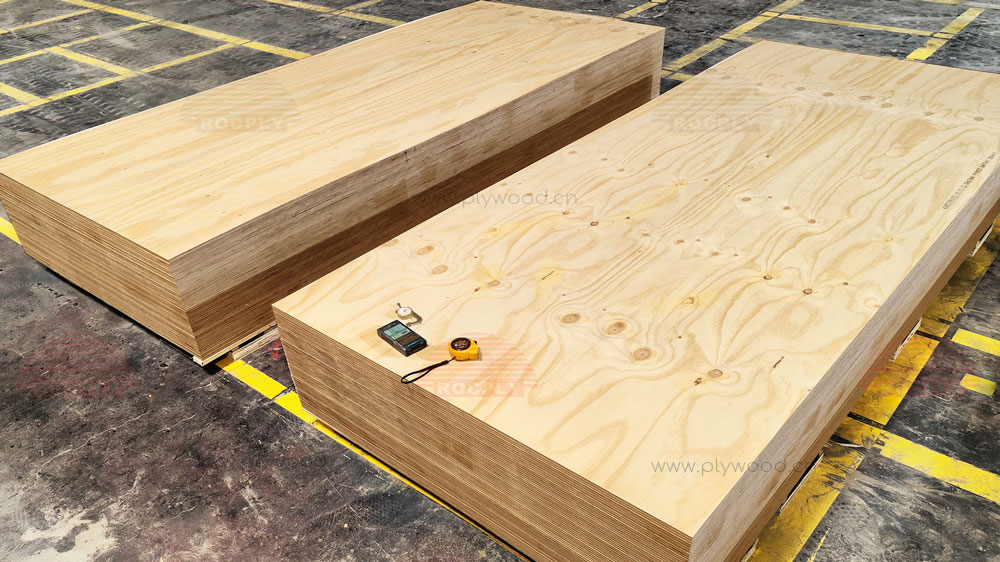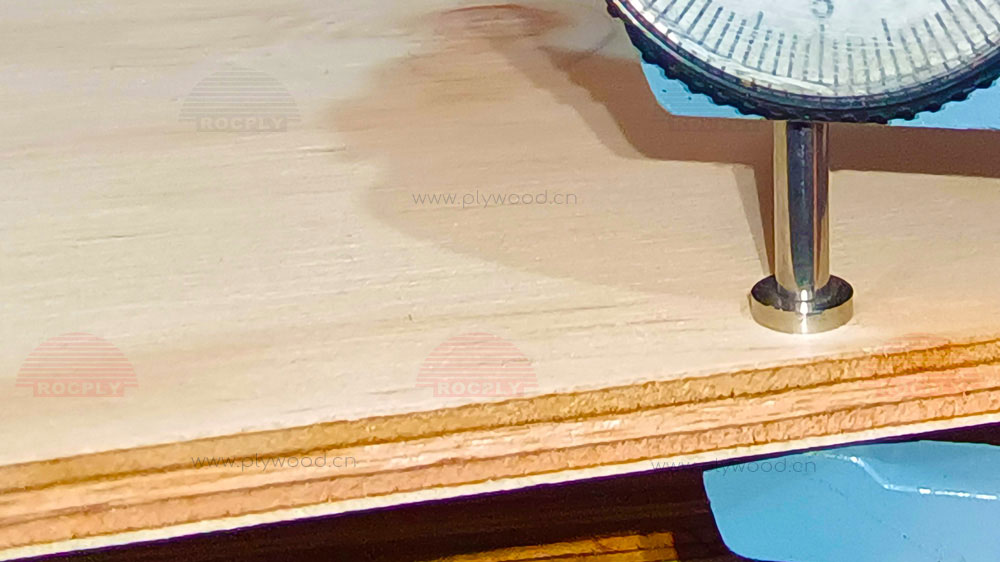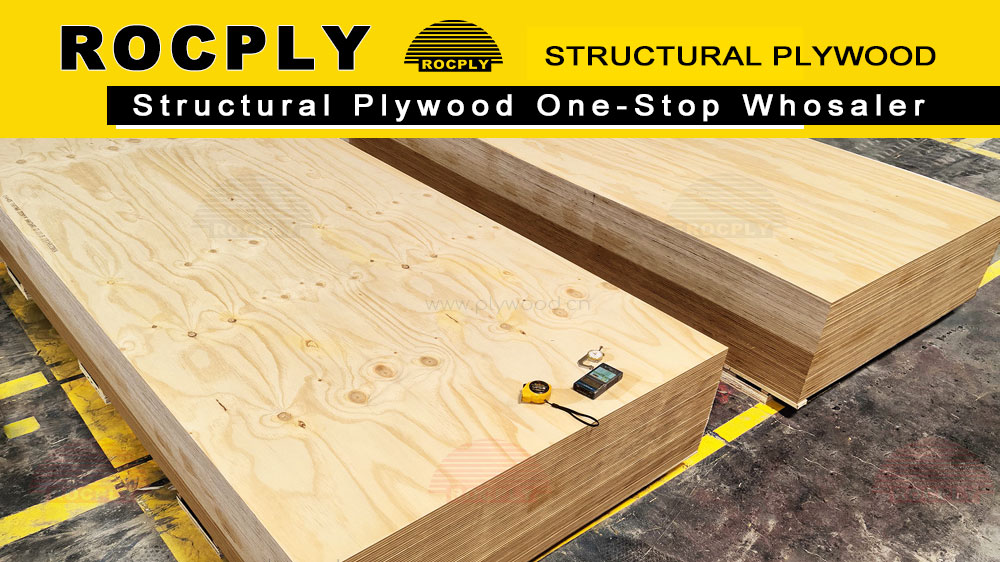What is Structural Plywood?
Structural plywood is an engineered wood panel designed to offer consistent strength and stability. It is formed by bonding layers of thin wood veneers under intense heat and pressure. Each layer’s grain aligns at right angles, reducing expansion, warping, and splitting. This balanced construction ensures reliable load-bearing capacity. Compared to non-structural boards, structural plywood withstands heavy stresses without losing integrity. Its uniform composition enables precise handling and accurate cuts. Builders trust it for floors, walls, and roofs, where a stable foundation matters. Structural plywood meets strict industry standards, ensuring long-term durability. Its layered composition resists moisture and deformation, enabling it to perform well even in demanding conditions. These properties make it a preferred choice for projects requiring solid, reliable panels.
Structural Plywood and Strength Under Pressure
Structural plywood ensures impressive load-bearing capacity. It endures heavy weights without buckling. Its layered structure maintains rigidity across various spans. Builders choose it to achieve greater support where other materials falter. Repeated stresses do not weaken its form. This reliability simplifies engineering calculations. Contractors can trust that their designs will hold up. Structural plywood thickness often matches demanding specifications. Denser cores improve dimensional stability. Compared to particleboard, it excels in bending strength. Its predictable performance reduces guesswork and lowers risk. Walls and roofs depend on its steady foundation. Even as climates shift, it maintains shape and firmness. Projects gain longevity from its enduring strength.
Comparing Structural Plywood with Traditional Timber
Timber beams sometimes twist under moisture changes. Structural plywood counters these effects. It remains flat, consistent, and easier to position. Timber may warp or split, adding complexity to construction. In contrast, structural plywood sheets come ready to install. They fit frames precisely, limiting the need for adjustments. This reduces labor and accelerates timelines. While solid wood can vary in density, structural plywood stays uniform. Builders reduce waste and improve resource efficiency. Lightweight panels ease transport and installation. Projects become safer and simpler. This difference boosts productivity. Construction teams appreciate stable materials that streamline their workflow.
Durability and Resistance in Challenging Environments
Environments with high humidity can damage ordinary materials. Structural plywood endures moisture without losing form. Adhesive resins lock veneers tightly. This prevents delamination. Even when exposed to repeated wet-dry cycles, it resists swelling. Structural plywood flooring in bathrooms or kitchens stays firm. Unlike materials that deteriorate, it maintains core strength. Termites and fungi often struggle to penetrate its layers. Its composition and treatment help deter such threats. Buildings in damp regions benefit from this long-term stability. Engineers prefer structural grade plywood for frameworks subjected to shifting conditions. This material’s resilience reduces costly repairs. Over time, it saves both money and effort.
Structural Plywood and Versatile Construction
Structural plywood adapts to many building applications. It suits floors, walls, and ceilings, offering a stable base for finishes. Carpenters use it for cabinets and built-ins that must remain sturdy. Structural plywood thickness can vary to match different needs. Thin panels serve decorative purposes, while thicker ones enhance load-bearing elements. In industrial settings, formwork plywood helps shape concrete structures. These temporary molds rely on panels that hold their form during pours. After curing, the plywood can be reused. This reduces material waste. The construction industry values such adaptability. Even under outdoor conditions, structural plywood resists bending. Decks and external cladding benefit from its support. Adaptability leads to design freedom and architectural creativity.
Structural Plywood in Roofing and Flooring Systems
Roofing requires materials that handle wind loads and temperature extremes. Structural plywood nails down securely without splitting. Its layered design stands firm against gusts. At ground level, flooring systems rely on rigidity. Structural plywood flooring reduces sagging, ensuring even surfaces. This helps prevent tripping hazards and floor damage over time. Contractors find installation straightforward. Panels align neatly, speeding up completion. Homeowners enjoy quieter floors with reduced squeaking. Under heavy appliances or foot traffic, the material endures. It resists denting or compression, maintaining its shape year after year. In renovations, it blends with existing structures easily. That versatility benefits both residential and commercial projects.
Enhancing Quality with Structural Grade Plywood
Some projects demand verified quality. Structural grade plywood meets strict industry classifications. These panels undergo testing and certification to ensure consistent performance. Builders trust them for critical load-bearing applications. This guarantees that every panel meets a certain standard. Consistency simplifies planning. Structural grade plywood delivers predictable outcomes. Engineers can accurately model load capacities. Clients gain assurance that structures meet code requirements. Certified panels often come labeled with specifications. This transparency streamlines material selection. Choosing structural grade plywood reduces uncertainty, enabling precise construction techniques. Overall, it contributes to safer buildings and fewer unexpected issues.
Comparing Structural Plywood to Other Engineered Panels
Many engineered wood products compete in the marketplace. Medium-density fiberboard may offer a smooth surface, but it lacks robust strength. Oriented strand board (OSB) costs less but can be weaker under certain loads. Structural plywood’s advantage lies in balanced layering. Its cross-grain alignment adds dimensional stability. OSB strands sometimes absorb moisture unevenly, causing swelling. Structural plywood stays tighter and more uniform. Builders factor in long-term durability when selecting materials. Over decades, slight differences in stability matter. Structural plywood flooring will remain level. Walls stay straight, reducing finishing work. While other boards have niche uses, structural plywood dominates where toughness is paramount.
Understanding Formwork Plywood Applications
In large-scale construction, concrete formwork shapes the project’s backbone. Formwork plywood holds liquid concrete as it sets. Panels must resist moisture, pressure, and chemical reactions. Structural plywood excels here. Its strong layers withstand hydrostatic loads. Contractors appreciate reusability. After the concrete hardens, panels detach cleanly. They can be reused multiple times if handled properly. This efficiency cuts costs and lowers waste. By using formwork plywood, builders maintain stable shapes and reduce material loss. The resulting concrete surfaces emerge smoother, requiring less finishing. Such precision saves labor and enhances project outcomes. Structural plywood’s quality ensures that formwork tasks proceed without complication.
Achieving Precision with CD Structural Plywood
Grades like CD structural plywood provide consistent veneer quality. Faces with minimal defects deliver uniform strength. Panels carry clear stamps indicating their intended use. Builders rely on these standards to match panels with applications. CD structural plywood stands out for its performance in essential areas. Its predictable density allows accurate fastening without splitting. Edges remain stable, enabling precise fitting. Projects benefit from reduced variability. Contractors know what to expect when cutting and joining panels. The result is a tighter construction process with less trial and error. Over time, consistent quality leads to better project outcomes and fewer unexpected setbacks.
Global Recognition and Standards for Structural Plywood
Worldwide, building codes recognize the performance of this material. Many countries enforce standards that ensure consistent quality. Structural plywood sheets must pass rigorous tests. These include bending, shear, and moisture resistance trials. Certifications help buyers identify reliable products. Suppliers list ratings, making selection easier. Engineers rely on documented properties to match panels with specific tasks. Such universal acceptance streamlines international trade. Construction firms source panels from distant markets, knowing they meet strict criteria. This broad recognition fosters trust and reduces uncertainty. Projects completed with certified panels face fewer compliance hurdles. Over time, these standards encourage continuous improvement. Manufacturers refine production methods, raising quality even higher.
Manufacturing Processes and Quality Assurance
Careful control defines the production process. Logs are peeled into thin veneers, then sorted and graded. Defect-free layers form the outer faces. Inner plies alternate grain direction to boost stability. Each layer bonds with strong adhesives. Temperature, pressure, and humidity remain tightly managed. Factories track each batch to ensure consistent quality. Random inspections catch defects before shipping. Clients can request panels tailored to their specifications. Structural plywood thickness can vary, but each sheet meets precise tolerances. This meticulous approach ensures uniformity. Buyers appreciate transparent processes and reliable outcomes. The result is a product that meets modern engineering demands. Consistency builds confidence in every project.
Hardwood Structural Plywood for Superior Performance
In some cases, builders choose hardwood structural plywood. These panels feature hardwood veneers that enhance strength. The dense fibers resist denting and splitting. Hardwood species introduce added toughness. Projects handling heavy loads benefit from this option. Floors in busy commercial spaces often use such panels. Their stability reduces maintenance and prolongs service life. Though slightly pricier, they repay the investment over time. Hardwood layers hold fasteners firmly, preventing loosening. This ensures floors, walls, and fittings remain secure. Designers gain flexibility, as hardwood structural plywood supports decorative finishes too. A well-chosen panel elevates quality and reduces long-term costs.
Environmental Considerations and Sustainability
Sustainability guides many construction decisions today. Manufacturers source veneers from responsibly managed forests. This reduces environmental impact. Certified plantations maintain biodiversity and protect habitats. Selecting structural plywood supports a renewable resource. Compared to steel or concrete, wood-based panels need less energy to produce. Lighter weight reduces shipping emissions. Proper adhesives limit harmful fumes. Disposal at the end of life can be simpler. Recycling or repurposing panels extends their usefulness. These choices align with evolving green standards. Environmental certifications reassure clients. They know they are investing in materials that respect nature. Over time, sustainable production methods become the norm. This supports a healthier planet and long-term resource security.
Balancing Durability with Environmental Responsibility
Durability and ecology need not conflict. Structural plywood flooring, for instance, offers longevity. Longer lifespans mean fewer replacements. Over decades, that lowers resource consumption. Builders reduce waste and landfill burden. Recycling off-cuts and repurposing old panels further lessens impact. Manufacturers embrace cleaner glues with fewer volatile compounds. These innovations reduce air pollution. As industry standards tighten, producers respond with greener solutions. Structural plywood evolves to meet both technical and ecological criteria. This synergy drives continuous improvement. Buyers gain options that serve functional and ethical goals. It becomes easier to build responsibly without compromising performance.
Cost and Availability of Structural Plywood
Budget often shapes material choices. Structural plywood delivers value through durability and versatility. While sometimes costlier than simple boards, it pays off. Reduced maintenance lowers long-term expenses. Projects complete faster as panels install smoothly. Labor savings offset initial costs. Global distribution networks ensure steady supply. Clients rarely face shortages or delays. Consistent availability enables large-scale projects without material gaps. Competitive markets keep prices reasonable. Over time, builders and developers understand the cost-benefit ratio. They appreciate a material that delivers stable results. Reliable panels help avoid expensive structural repairs later. For most projects, structural plywood offers a fair balance between upfront and ongoing costs.
Meeting Specific Project Requirements
Not all sites present the same challenges. Some require thicker panels or enhanced moisture resistance. Others need formwork plywood for shaping concrete elements. Suppliers cater to these variations. Custom orders and special grades address unique conditions. Engineers review load calculations and environmental factors. They select panels best suited to the job. This tailored approach improves final outcomes. Instead of forced compromises, builders choose the right product from the start. Project managers enjoy predictability. Contractors avoid surprises during installation. Every choice aligns with project objectives. By meeting exact requirements, structural plywood supports creativity and innovation.
Handling, Storage, and Installation Tips
Proper storage protects panels from unnecessary damage. Keep them flat, off damp floors. Cover to shield from direct rain. Good ventilation prevents mildew. During cutting, use sharp blades for clean edges. Avoid forcing fasteners that could split layers. Pre-drilling helps in dense hardwood veneers. Align panels carefully to reduce gaps. Level supports prevent sagging. Efficient installation means fewer callbacks. Builders find structural plywood flooring straightforward to lay. Walls and ceilings fit together with minimal trimming. Once installed, periodic checks ensure everything remains stable. Following recommended practices extends service life. Skilled handling preserves panel integrity and appearance.
Ensuring Safety During Construction
Safety is a priority. Structural plywood’s predictability helps maintain structural integrity. Secure fastening keeps panels in place. Workers handle lightweight sheets with ease. This reduces strain and accidents. Smooth surfaces lower splinter risks. Consistent thickness supports stable scaffolds. Reliable load distribution prevents unexpected failures. Complying with building codes ensures safety benchmarks are met. Regular inspections confirm that materials perform as intended. Over time, well-executed projects face fewer structural issues. Everyone benefits from a secure environment. The reliability of these panels contributes to safer construction sites and stronger buildings.
Aesthetic and Finishing Options
Though valued for strength, this material can also enhance aesthetics. Sanded surfaces accept paints, stains, or laminates. Designers can add decorative veneers on visible areas. Structural plywood sheets form a flat canvas for creative treatments. Smooth finishes improve lighting reflections and interior brightness. In exposed beams, the layered texture adds character. Furniture makers appreciate consistent density for detailed joinery. With careful finishing, these panels blend seamlessly into interior décor. They become part of the design narrative. This versatility appeals to architects and interior designers. They can combine strength with style. Results please clients seeking durable yet appealing spaces.
Integrating with Other Materials
Structural plywood combines well with metals, glass, or composites. Mixed materials add depth and interest. Frames and supports merge seamlessly. The panel’s stable base allows precise alignment. Finishes adhere well, ensuring lasting results. By integrating these boards into broader schemes, designers create harmonious effects. The finished structure offers both practicality and flair. Stairs, partitions, and fittings merge into a cohesive whole. This synergy boosts overall project value. Buyers gain spaces that are both functional and attractive. By pairing structural plywood with complementary materials, creativity thrives. Builders no longer face a choice between utility and beauty. They enjoy both.
Future Trends and Innovations
The construction industry evolves. Manufacturers invest in advanced adhesives and treatments. Stronger panels with thinner profiles emerge. Lighter, more efficient boards reduce transportation costs. Digitally driven production ensures consistent quality. Environmental certifications become more common. Researchers study new wood species for veneers. Innovations improve long-term durability and resistance. Fire-retardant finishes increase safety. Smart coatings may repel water or dust. Prefabrication gains popularity, using panels cut to exact dimensions. This reduces site waste and labor. Structural plywood adapts to changing demands and regulations. As trends shift, this material remains relevant. It stands ready to meet future challenges.
Balancing Tradition and Technology
Though advanced techniques shape production, the essence remains wood-based. Traditional craftsmanship merges with modern methods. This balance retains the natural warmth of timber. Emerging designs celebrate authenticity. Rustic themes contrast with sleek materials. Structural plywood adapts to both old and new. Architects leverage its stability for contemporary visions. Restoration projects use it to reinforce historic buildings. Innovation coexists with timeless appeal. Materials that last decades align with a sustainable future. Builders combine technology and tradition to achieve optimal results. Structural plywood remains a bridge between past and present construction ideals. This adaptability secures its place in tomorrow’s projects.
Maintenance and Long-Term Care
Once installed, this material demands minimal upkeep. Occasional inspections verify stability. If panels become damp, proper ventilation or sealing prevents long-term harm. Minor surface wear can be sanded out. Protective coatings prolong life. Regular cleaning maintains surfaces, especially in high-traffic areas. Structural plywood flooring endures steady use without losing form. Attention to details preserves aesthetic appeal. Professional advice helps address unique conditions. Timely checks prevent minor issues from spreading. Over decades, these panels continue performing. Their reliability reduces maintenance schedules. Owners enjoy fewer surprises and expenses. This long service life supports cost-effective construction. It also enhances property value.
Addressing Repairs if Needed
In rare cases, damage may occur. Replacing a panel is simpler than fixing massive structural elements. Standard dimensions ensure easy sourcing of spares. Skilled carpenters remove and reinstall panels swiftly. This targeted approach reduces downtime. No need to rebuild entire sections. Renovations become less intrusive. Efficient repairs extend the building’s overall lifespan. The durability and modularity of structural plywood support ongoing adaptability. Buildings remain functional and aesthetically pleasing. Homeowners and facility managers rest easy knowing solutions exist. This practicality reduces stress and uncertainty. Over time, the building stays strong, meeting evolving needs with minimal fuss.
Practical Tips for Material Selection
When choosing panels, verify certifications. Confirm thickness and grade against project demands. Consider environmental factors like humidity. Assess load requirements thoroughly. Consult experts if uncertain. Contractors and suppliers offer guidance. Compare prices and check warranties. Some projects benefit from formwork plywood, while others need decorative finishes. Ensure each panel aligns with safety and quality standards. By planning ahead, designers avoid last-minute compromises. With proper selection, structural plywood excels in every application. Thoughtful decisions lead to smoother installations. Clients appreciate professionalism and informed choices. This careful approach results in stable, efficient structures. Over time, these buildings become lasting assets.
Structural Plywood Frequently Asked Questions (FAQs)
Q: Can these panels handle heavy loads in flooring systems?
A: Yes. Correctly installed panels maintain rigidity and strength under significant weight.
Q: Are special treatments needed to resist moisture?
A: Often, panels include moisture-resistant adhesives. Proper sealing and ventilation can enhance their resilience.
Q: Do building codes accept this material?
A: Most major codes approve it. Check local regulations and certifications before starting projects.
Q: Is it suitable for both indoor and outdoor use?
A: Yes. With proper finishes and sealing, it can perform reliably in various environments.
Q: Can I use thinner sheets for decorative elements?
A: Yes. Thinner panels work well for non-structural features, allowing flexibility in design.
Q: Does it come in a range of thicknesses?
A: Yes. Structural plywood thickness varies widely, ensuring suitable panels for different applications.
Post time: Jan-04-2025




